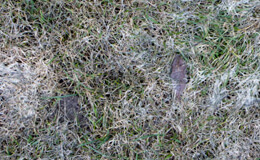When it comes to keeping one's lawn healthy, serious gardeners will know how important it is to stay on top of things and keep the grass well maintained.
That being said, even if you’re not an avid gardener, it doesn’t take Alan Titchmarsh to run the mower over the lawn to keep your garden from becoming a jungle.
After all, when the sun’s got its hat on, the garden can be a really great place to enjoy some downtime, whether you’re kicking a ball around with the kids or simply kicking back with a beer or two.
However, Mother Nature does have a habit of throwing a green-handled spanner in the works from time to time. From a lawn care perspective, this can often come in the form of grass fungus and lawn disease.
Know your enemy and keep your garden from falling foul of fungus with this handy guide to the most common lawn diseases in the UK.

Common types of grass fungus
Grass fungus can ruin a lawn almost beyond repair, so it's important to know what you're looking for. Here are three of the worst offenders to look out for in your garden:
Lawn Rust
As the name suggests, this bothersome blemish can leave an unsightly copper-brown stain on your beautiful green lawn, making it look more like military camouflage than the viridescent showroom shade of old. Worse still, lawn rust can often spread wildly due to the high volume of spore coverage.
Like any rustable element, the best way to avoid rust is to stay active. Actively keeping your lawn well-maintained throughout the year will help keep rust at bay, so be sure to remove excess thatch and keep your lawn well fertilised. However, take care to avoid fertilisers rich in nitrogen as this can have an adverse effect.
Lawn rust thrives on stressed, unhealthy grass and is especially common during summer periods of drought. As such, it’s important to take particular care during the summer months, when hot weather and reduced rainfall can have a significant impact.
If lawn rust has already hooked its coppery claws into your grass, it can be difficult to remove, even with the aid of an all-purpose fungicide. Patience is a virtue and, in this case, you’re just going to have to be very virtuous – it will go in time, so be prepared to ride out the storm.
Red Thread
Clawing its way into your garden as early as late springtime, this summery fungus is a bit like acne for your lawn. Red thread causes patches of pale, reddish pink to appear in blotchy spots across your garden.
Incredibly common in the UK, red thread is often mistaken for drought. However, it actually thrives in mild, damp conditions.
To avoid an invasion from the dreaded thread of red, ensure your garden has an efficient drainage system. Scarification to remove excess thatch can also help prevent red thread, while evening watering should also be avoided.
If you are too late for preventative measures, fungicide is a wise course of action. While this won’t cure existing patches, it will help to stop them in their tracks, allowing healthy green grass to grow back in its place. Iron sulphate can help give your lawn a fighting chance of recovery, while also helping to avoid a rematch.
Snow Mould
The troublesome twin of red thread, snow mould is the autumn/winter equivalent of its spring/summer sibling. Named for its penchant for growth under snow cover, snow mould is characterised by yellowy rings, often accompanied by a slimy white covering that can resemble cobwebs.
Healthy lawns can fight back, whereas a weaker surface may be vulnerable to attack. A well-fertilised lawn, rich in nutrients, will stand the best chance of fending off this frost-loving fiend, while iron sulphate is once again an iron-clad prevention method that’s well worth using.
As with red thread, prevention is better than cure, so scarification and drainage are your best allies here. If you are too late and snow mould has already taken hold, fungicide is again the best defence. Remove dead grass and reseed if necessary, taking care to take the aforementioned preventative steps in future to avoid a relapse.
Top tips for removing grass fungus
Aside from the the usual suspects listed above, grass fungus can come in many forms and strike at various times of the year in a variety of conditions. That being said, like any living organism, a lawn that’s healthy and strong stands the best chance of fighting off these disruptive diseases.
As the old saying goes, defence is the best form of attack, so keep your guard up all year round by effectively maintaining your lawn. Removal of thatch via scarification is a great way to avoid a fungal fright, as is fertilisation.
Be sure to keep an eye on your lawn, scarify when necessary, and ensure it's well fertilised from season to season. Iron sulphate is a great all-purpose fungus deterrent that’s effective on a variety of common fungi, so don’t be afraid to give your lawn a visit from the Iron Man to lay down the law on your lawn.
So there you have it: a handful of top tips to keep your lawn fungus free. For more info on how to maintain your lawn, get in touch with Lawn & Weed Expert today!
Request a FREE Survey